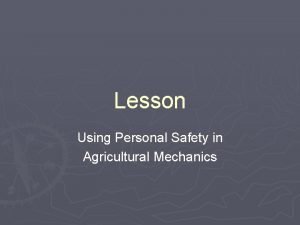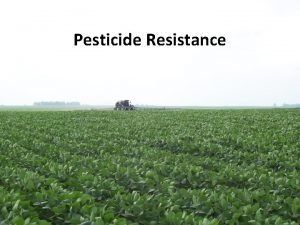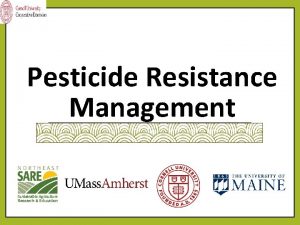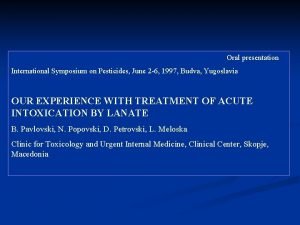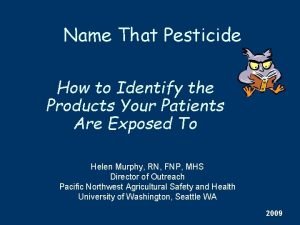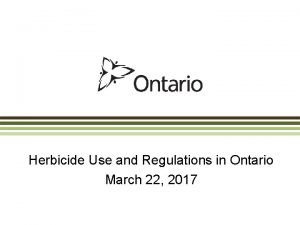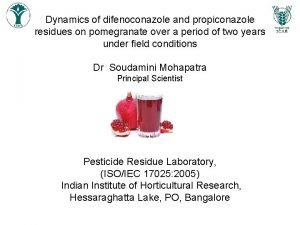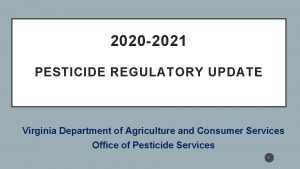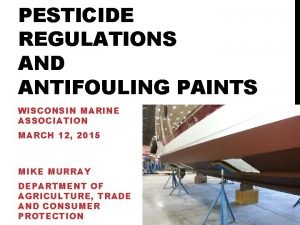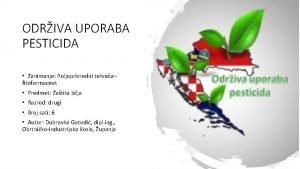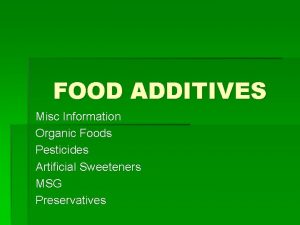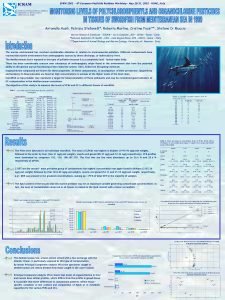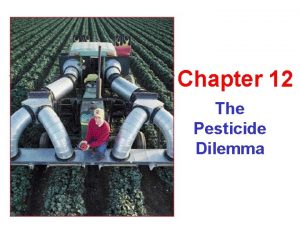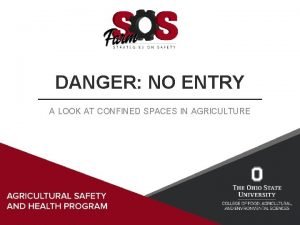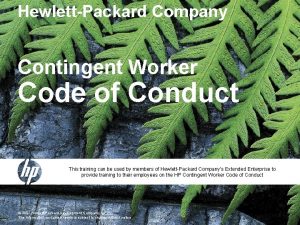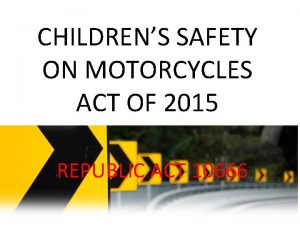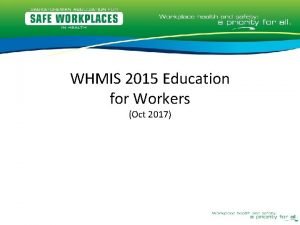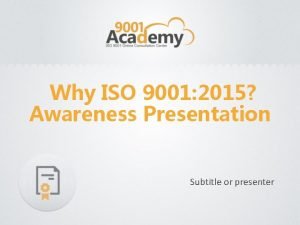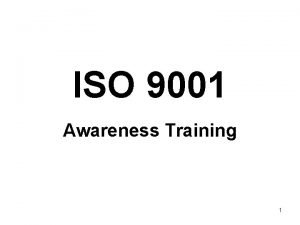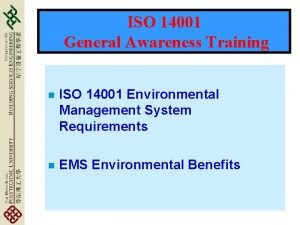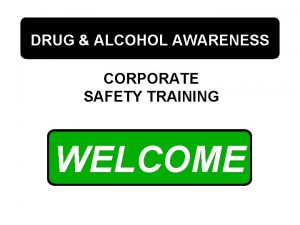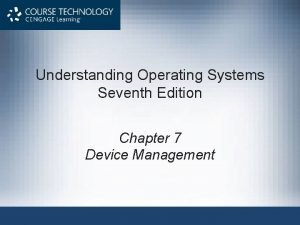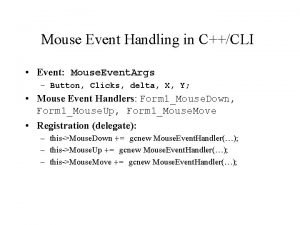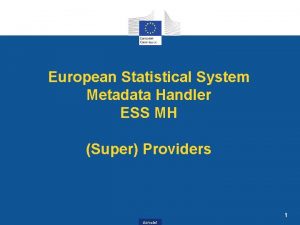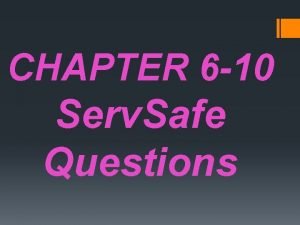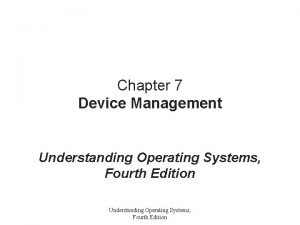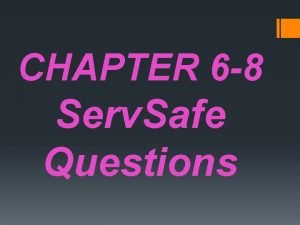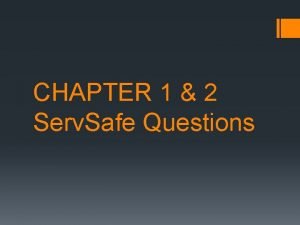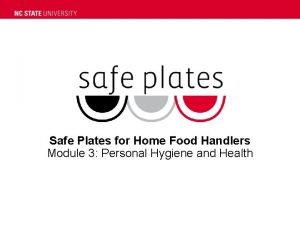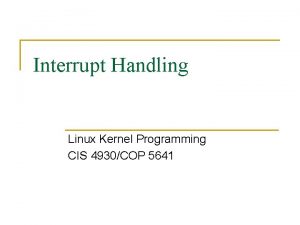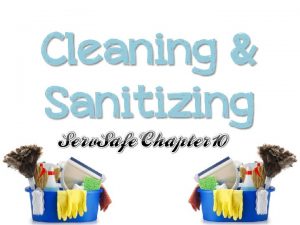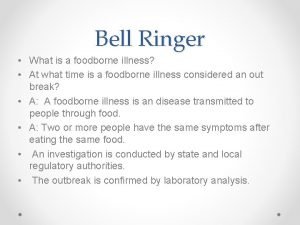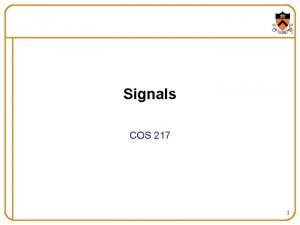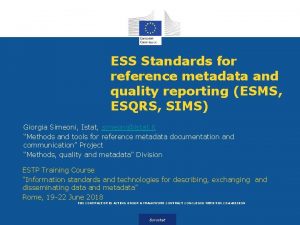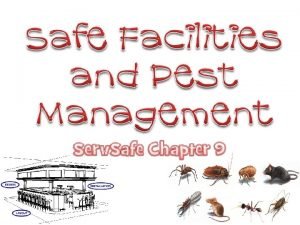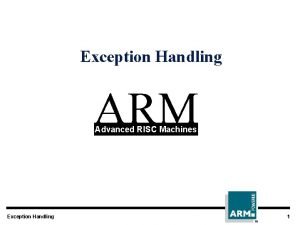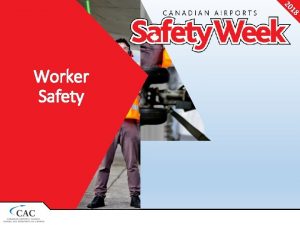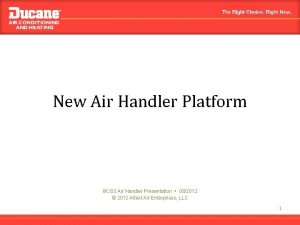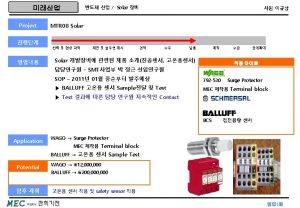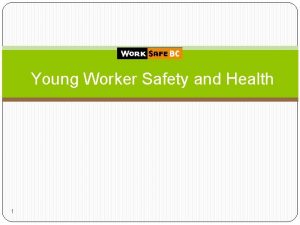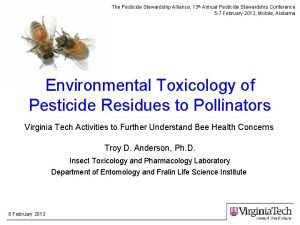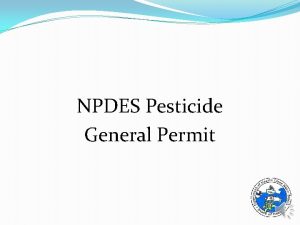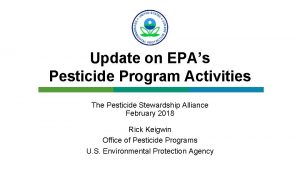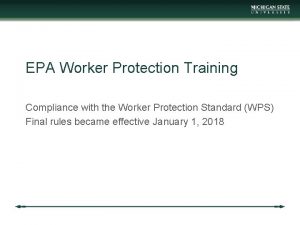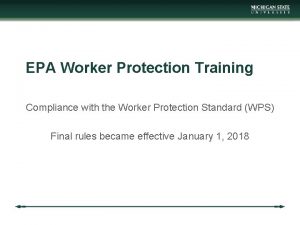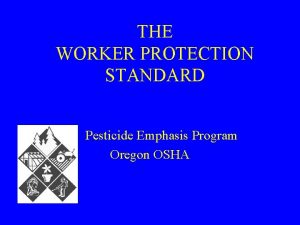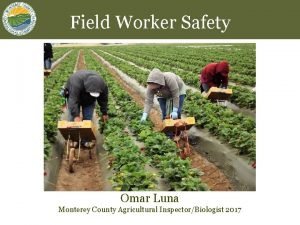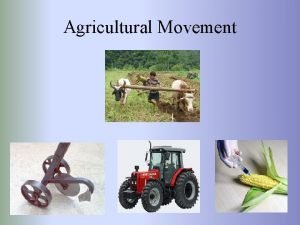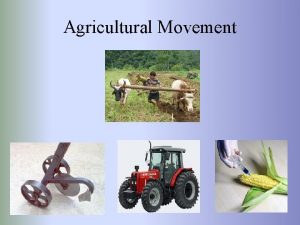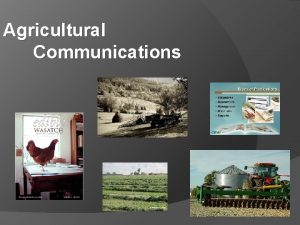Agricultural Worker and Handler Pesticide Safety Training 2015






























































- Slides: 62

Agricultural Worker and Handler Pesticide Safety Training 2015 Worker Protection Standard Image credit: Joyce Hornstein, Iowa State University Image credit: Lance Cheung, USDA

EPA has approved this material for training workers and handlers on pesticide safety in accordance with the 2015 WPS expanded training content (40 CFR Part 170). The approval number is EPA Worker and Handler PST 00022.

Using these slides to train workers and handlers • This presentation provides the information required to train workers and handlers under the Environmental Protection Agency’s Worker Protection Standard. • This worker/handler training material can be used in 2017, 2018 and beyond. • To train workers, slides 1 through 39 of this presentation must be presented. • To train handlers, this presentation must be presented in its entirety. • If you add or remove slides from this set, you must submit the training to EPA for approval before it may be used to train workers/handlers. • Please review the notes section of this presentation prior to conducting the training. • Trainings must be conducted in a manner such that the workers understand the information completely.

What is the purpose of this training? • Provide you with information on the potential risks of working in areas where pesticides are being used and pesticide residues may be found • Complete annual training requirements of Worker Protection Standard

Workers • Do tasks related to the production of agricultural plants on an agricultural establishment • Examples: weeding, planting, pruning, harvesting • CANNOT handle or apply pesticides Image credit: Betsy Buffington, Iowa State University

Handlers • Mix, load, transfer, and apply pesticides • Dispose of pesticides or pesticide containers • Handle open pesticide containers • Work as flaggers • Must be at least 18 years old Image credit: Mike White, Iowa State University

What are pesticides? • Herbicides, insecticides, and fungicides Image credit: Mike White, Iowa State University

What forms of pesticides can be encountered during work activity? • Liquids • Dusts • Granules • Gases • Residues Image credit: Kristine Schaefer, Iowa State University

Potential sources of pesticide exposure • Treated plants and soil • Tractors, sprayers, and other application equipment • Irrigation equipment • Work clothing, shoes, and Personal Protection Equipment (PPE) Image credit: Betsy Buffington, Iowa State University

Pesticides may drift through the air from nearby applications • Drift – when a pesticide application moves beyond the application site to a place it is not wanted Image credit: Kristine Schaefer, Iowa State University

Pesticides may be in irrigation water • Chemigation – the use of irrigation water to apply pesticides to soils and crops Image credit: Brenda Carson, Depositphotos

Routes through which pesticides can enter the body Oral Inhalation Ocular Dermal

Skin exposure • Skin comes in direct contact with pesticides or pesticide residues • Rash, blisters, skin irritations

Eye exposure • Pesticide drift • Rubbing eyes with unwashed hands

Respiratory exposure • Vapor or dust from pesticide drift • Entering treated areas

Oral exposure • Drink, smoke, eat, or chew gum with unwashed hands • Unwashed produce • Drinking from pesticide containers • Drinking irrigation water

Potential pesticide hazards • Acute effects happen quickly during or after exposure • Delayed effects may take time to develop after an exposure • Chronic effects are the result of exposures over a long period of time • Sensitization is the gradual development of an allergic reaction to pesticides

Acute pesticide injury Headaches Loss of consciousness Eye irritation Nose pain Throat pain Chest pain Skin irritation Skin rashes Difficulty breathing Nausea

Severe acute poisoning Unconsciousness Chest pain Breathing difficulty Lack of muscle control Severe constriction of pupils Salivation Drooling

Long-term health effects • Cancer • Miscarriages • Birth defects • Nervous system disorders • Organ damage

Hazards to children and pregnant women • Pesticide exposure can be hazardous to pregnant women • Children are more susceptible to effects of pesticides • Keep all non-working family members and children away from pesticide areas Image credit: Betsy Buffington, Iowa State University

Reducing the risk of pesticide exposure • During pesticide application • Only handlers can enter and work • During REI • Only handlers and early-entry workers can enter • After REI expires • All WPS-trained employees can enter Restricted Entry Interval (REI) - the amount of time that must pass before it is safe for a worker to reenter a pesticide treated area

Early-entry workers • Must be 18 years of age or older • Need additional instructions and information Image credit: Betsy Buffington, Iowa State University

Notification about pesticide applications Image credit: Betsy Buffington, Iowa State University

Central location • Pesticide safety information • Emergency information • Pesticide regulatory agency contact information • Pesticide application information Image credit: Betsy Buffington, Iowa State University

Pesticide safety information Image credit: Betsy Buffington, Iowa State University

Pesticide application information Image credit: Betsy Buffington, Iowa State University

• Pesticide hazards • Emergency medical treatment Image credit: Carol Black, Washington State University Safety Data Sheets

• Person chosen by worker or handler to access or request and obtain pesticide application and hazard information Image credit: Betsy Buffington, Iowa State University What is a designated representative?

Oral warning and warning sign posting • Face-to-face warning • When you see this sign, do NOT go into this area!

Reducing hazards from pesticide drift • Leave immediately if you are working where someone is applying a pesticide or if pesticides are drifting towards you Image credit: Lance Cheung, USDA

Work clothing • Always wear work clothing that protects you from pesticide residues

Routine decontamination at work Image credit: Linda Naeve, Iowa State University • Wash your hands before: • Touching your eyes or mouth • Eating • Drinking • Smoking • Chewing gum • Chewing tobacco • Using the toilet

Decontamination supplies

Routine decontamination at home 1. Remove work shoes before entering your home 2. Shower/bathe and shampoo hair immediately after work 3. Change into clean clothes before any physical contact with children and your family 4. Put work clothes into a bag to prevent others from coming into contact with them 5. Wash work clothes before wearing them again 6. Wash work clothes separately from all other laundry 7. Tell the person washing your clothes that they may have pesticide residues on them

Do not take pesticides or pesticide containers used at work home with you Image credit: Betsy Buffington, Iowa State University

Image credit: Piotr Marcinski, Depositphotos How and when to get emergency medical care • Contact your supervisor • Employer must provide immediate transportation to nearest emergency medical facility

Emergency First Aid • Skin exposure • Eye exposure • Oral exposure • Respiratory exposure Image credit: Catalin Petolea, Depositphotos

Employee rights and protections against retaliatory acts • Employers cannot punish you for attempting to comply with WPS • Contact the Iowa Department of Agriculture and Land Stewardship (IDALS) • 515 -281 -8591 Image credit: Vyacheslav Volkov, Depositphotos

This concludes the worker training The remainder of the training is for handlers only

Using pesticides safely Information for Pesticide Handlers only Image credit: Joyce Hornstein, Iowa State University

Mixing and loading pesticides • Read the label directions • Wear PPE • Measure pesticides carefully • Prevent pesticides from entering the water source • Never mix, load, or clean equipment near water sources

Applying pesticides • Follow label application instructions • Check application equipment and make repairs as necessary • Do not apply pesticides in a manner that results in contact with workers or other persons • Clean equipment

Transporting pesticides • Transport pesticides in the truck bed, cargo area, or on the back of the spray rig • Check containers for leaks before loading and unloading • Protect containers from rain and other potential weather damage • Secure or tie down all pesticide containers in the cargo area • Monitor containers at all times during transportation • Keep containers in a locked area

Spill cleanup • Control • Contain • Clean up Image credit: Betsy Buffington, Iowa State University

Storing pesticides • Ensure that containers are tightly closed and stored upright • Check containers for leaks, breaks, or weak spots • Clean up spills and leaks immediately • Keep storage area locked

Disposing of pesticides and containers • Always comply with label directions and federal, state, and local laws and regulations

Protect sensitive areas • Drift – movement of pesticide dust, spray, or vapor away from the application site • Runoff – movement of water and associated materials on the soil surface • Non-target organisms – plants or animals that are not the intended targets of pesticide applications • e. g. , bees and other pollinators, livestock, wildlife

Application exclusion zone Workers and other persons are restricted from entering an AEZ when pesticide applications are taking place 25’ 100’

Pesticide label Image credit: Betsy Buffington, Iowa State University

Pesticide brand name, ingredients, and EPA registration number Brand name BUGG-OUT Insecticide Active Ingredient: Imidacloprid, 1 -[(6 -Chloro-3 -pyridinyl)methyl)]-N-nitro-2 imidazolidinimine……. ………………………… 1. 0% Inert Ingredients: . . ………. 99. 0% TOTAL 100% EPA Reg. No. 34890 -69 EPA Est. No. 5905 -IA-001

Signal Words and symbols KEEP OUT OF REACH OF CHILDREN DANGER-POISON PELIGRO DANGER-POISON – Highly toxic DANGER – Highly toxic WARNING – Moderately toxic CAUTION – Slightly toxic

First aid statements FIRST AID If swallowed: • Call a poison control center or doctor immediately for treatment advice. • Do not induce vomiting unless told to do so by a poison control center or doctor. If on skin or clothing: • Take off contaminated clothing • Rinse skin immediately with plenty of water for 15 -20 minutes. If in eyes: • Hold eye open and rinse slowly and gently with water for 1520 minutes. If Inhaled: • If person is not breathing, call 911 or an ambulance, then give artificial respiration. NOTE TO PHYSICIAN: There is no specific antidote for BUGG-OUT. If this product is ingested, induce emesis or lavage stomach.

Precautionary statements HAZARDS TO HUMANS AND DOMESTIC ANIMALS CAUTION. Harmful if swallowed. Avoid breathing of dust. Do not take internally. Causes moderate eye irritation. Avoid contact with eyes, skin, or clothing. PERSONAL PROTECTIVE EQUIPMENT (PPE) Mixers, loaders, and applicators must wear: Long-sleeved shirt and long pants, chemical-resistant gloves such as polyethylene or polyvinyl chloride, shoes plus socks and chemical-resistant apron, when mixing/loading, cleaning up spills, cleaning equipment, or otherwise exposed to the concentrate. ENVIRONMENTAL HAZARDS BUGG-OUT is highly toxic to fish and aquatic invertebrates. Do not apply directly to water, to areas where surface water is present, or to intertidal areas below the mean high water mark. Do not contaminate water when disposing of equipment washwaters. PHYSICAL AND CHEMICAL HAZARDS Do not use, pour, spill or store near heat or open flame.

Directions for use DIRECTIONS FOR USE It is a violation of Federal Law to use this product in a manner inconsistent with its labeling. Application: Stonefruit – Webworm, leafroller, leaftier, moth and caterpillar Rate: 8 -16 fl oz/acre Methods: Broadcast/Foliar Ground Timings: At first sign of larval infestation. Limitations, Restrictions, Exceptions: Stonefruit restrictions: Do not apply after petal fall. Do not exceed 2 applications in any given season. Do not exceed 0. 50 lb ai (32 fl oz) per acre in any given season. Allow at least 21 days between applications. Webworm, leafroller, leaftier, moth and caterpillar: Apply BUGG-OUT at first sign of larval infestation. Use the higher rate for longer residual control, higher pest infestations, low crop load, larger trees or heavy dense foliage. Ground applications should be made in sufficient water for thorough coverage, using at least 50 gallons per acre for small trees (10 feet tall) and at least 100 gallons per acre for larger trees. Using insufficient water for thorough coverage

Agricultural use requirements AGRICULTURAL USE REQUIREMENTS Use this product only in accordance with its labeling and with the Worker Protection Standard, 40 CFR Part 170. This standard contains requirements for the protection of agricultural workers on farms, forests, nurseries, and greenhouses, and handlers of agricultural pesticides… Do not enter or allow worker entry into treated areas during the restricted -entry interval (REI) of 48 hours. PPE required for early entry to treated areas that is permitted under the Worker Protection Standard and that involves contact with anything that has been treated, such as plants, soil, or water, is: • Long-sleeved shirt and long pants • Chemical-resistant gloves such as polyethylene • Chemical-resistant footwear plus socks • Chemical-resistant apron

Personal protective equipment

Personal Protective Equipment • Your employer must provide you with all labelrequired PPE in clean and operating condition and make sure you are wearing it correctly • Inspect PPE for damage each day and discard any that cannot be repaired • Your employer must provide a clean place away from pesticide storage and pesticide use areas where you can put on and remove PPE and store your personal clothing • Do not wear home or take home PPE that has been used

Personal Protective Equipment It is the responsibility of your employer to: • Clean and dry the PPE at the end of the day • Store PPE separately from personal clothing and other personal items • Do not store PPE in a pesticide-contaminated area and never store PPE in the pesticide storage room • Keep contaminated PPE separate and wash it separately from other laundry • Make sure the person who cleans or launders PPE knows that it might be contaminated with pesticides

Respiratory protection • Medical evaluation • Respirator fit test • Respirator training Image credit: Betsy Buffington, Iowa State University

Heat stress • Many symptoms of heat illness are similar to symptoms of pesticide poisoning • Drink plenty of water before, during, and after work Image credit: Catalin Pop, Depositphotos

This concludes the handler training This project has been funded by the Iowa Department of Agriculture and Land Stewardship through a grant from the U. S. Environmental Protection Agency.
 How to become a family support worker
How to become a family support worker Safety care training
Safety care training Unit 4 personal safety in agricultural mechanics
Unit 4 personal safety in agricultural mechanics Pesticide resistance
Pesticide resistance Pesticide resistance
Pesticide resistance Lanate pesticide
Lanate pesticide Pesticide classification chart
Pesticide classification chart Ontario pesticide regulations
Ontario pesticide regulations Agriculture pesticide difenoconazole
Agriculture pesticide difenoconazole Virginia pesticide registration
Virginia pesticide registration Wisconsin pesticide applicator license
Wisconsin pesticide applicator license Tablica miješanja pesticida
Tablica miješanja pesticida Organic food additives
Organic food additives Pesticide educational resources collaborative
Pesticide educational resources collaborative European pesticide residue workshop
European pesticide residue workshop Pesticide treadmill definition
Pesticide treadmill definition Agricultural confined space training
Agricultural confined space training Altar workers training manual pdf
Altar workers training manual pdf Hp code of ethics
Hp code of ethics What is the children’s safety on motorcycles act of 2015?
What is the children’s safety on motorcycles act of 2015? Two signal words used on whmis 2015 labels
Two signal words used on whmis 2015 labels Iso 9001 presentation
Iso 9001 presentation Iso 9001 awareness training
Iso 9001 awareness training Iso 14001 awareness training
Iso 14001 awareness training Drug and alcohol safety training
Drug and alcohol safety training Device handler seek strategies
Device handler seek strategies Ettie in the mark characteristics
Ettie in the mark characteristics Eurostat metadata
Eurostat metadata Rough terrain cargo handler
Rough terrain cargo handler Exception handling in php example
Exception handling in php example C++ event handler
C++ event handler Uart interrupts
Uart interrupts Fhc food handler classes
Fhc food handler classes Ess mh
Ess mh Robert handler gartner
Robert handler gartner Handlers classification
Handlers classification J_security_check aem
J_security_check aem Ruth
Ruth Signage posted at a handwashing station must include
Signage posted at a handwashing station must include C# async event handler
C# async event handler Android timer example
Android timer example A food handler is reheating commercially processed cheese
A food handler is reheating commercially processed cheese Device management in operating system
Device management in operating system A food handler pulled a hotel pan
A food handler pulled a hotel pan A food handler stored a sanitizer spray bottle
A food handler stored a sanitizer spray bottle What jewelry can food handlers wear while working
What jewelry can food handlers wear while working Reportable symptoms of food handlers include
Reportable symptoms of food handlers include Php throw exception
Php throw exception Interrupt handling in linux
Interrupt handling in linux No irq handler for vector
No irq handler for vector Awteventlistener
Awteventlistener What is sanitization
What is sanitization A food handler who has just bussed tables
A food handler who has just bussed tables Cos 217
Cos 217 Soft irq
Soft irq Esqrs
Esqrs When installing tabletop equipment on legs
When installing tabletop equipment on legs Fatal trap 12: page fault while in kernel mode
Fatal trap 12: page fault while in kernel mode Arm exception handling
Arm exception handling No irq handler for vector
No irq handler for vector Android event handling
Android event handling Agricultural accounting and finance kansas
Agricultural accounting and finance kansas Chapter 9 agricultural transformation and rural development
Chapter 9 agricultural transformation and rural development


